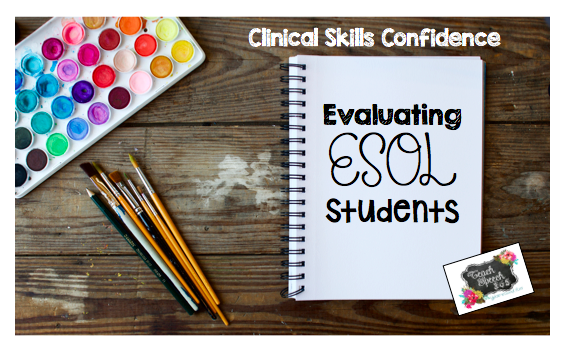Clinical Skills Confidence: Evaluating ESOL Students

It’s time for another Clinical Skills Confidence post! My school has a high percentage of ESOL students. I believe the terms vary by state and district, but I’m talking about students whose home language is not English. I’m beginning my 4th year at this particular school and my 7th year in my career. Trust me when I say, I still question myself daily when evaluating these students for speech and language disorders. I’m still learning a lot when it comes to this population and how best to serve them.
ASHA provides a wealth of information on this topic (look at Multicultural Issues in Assessment section). First and foremost, you never want to label a student with a disorder, when they are simply presenting with a difference. For example, your student has an accent. Is that a disorder? NO! It’s just a difference and therefore does not require your services. So how does one go about evaluating a student when the teacher has concerns about a speech/language disorder?
At the initial referral meeting (I know the names of these meetings vary), it’s important to ask parents about speech/language milestones and what they are noticing at home IN THE HOME LANGUAGE. Often, I have parents who note that their child doesn’t typically speak in full sentences at home, drop word endings, have trouble expressing themselves, etc. These are red flags for a true disorder. You can glean a lot of information from this one meeting.
Next, you need to work with a trained interpreter. In my district, interpreters have to be specifically trained to help assess a student and to participate in IEP and eligibility meetings, as there is a lot of technical jargon. The interpreter must be aware that while helping you assess, they shouldn’t add information for the student or tell the student what they answered correctly or incorrectly. Once I find an interpreter I work well with, I tend to use him/her over and over again. I like using the same interpreter who helped me assess for the eligibility/IEP meetings because he/she knows the student. While assessing, I like to have the interpreter informally talk to the student in the home language and get a feel for their language skills. I’ll ask what kinds of things the interpreter noticed, such as: is the student difficult to understand, can he/she answer questions correctly, grammar skills, etc.
For articulation, it’s important to make sure that the sounds that you would work on in therapy appear in the home language. I use the phonemic inventories from ASHA A LOT to check on overlapping phonemes. I love the easy to read format, and I often print them out to show parents what sounds I’ll be working on and explain why.
For language, some grammar aspects are not seen in other languages, so this can pose additional questions when doing language intervention. I find this resource very helpful to figure out what to focus on for therapy for Spanish speaking students (this is the most common second language in my school).
I do not report test scores for these students. These tests are typically not normed on students who are exposed to more than one language, so it’s not a fair representation of their overall skills. I do score the tests, just to get an idea but I do not include the scores in my reports.
I feel that the best information I get is from the interpreter on what the student’s skills are like in the home language, as well as from an informal language sample in English. Collaborating with the ESOL teachers in these cases is also very important as they can provide you with more information on if the student is progressing at an expected rate to become proficient in English.
It’s also important to talk to the teacher and get a read on how the student performs in the classroom. After all, we have to consider educational impact. A classroom observation is a good way to do this. I like to use my (free) classroom observation form for this.
Of course, these are not all the things to keep in mind when evaluating ESOL students, but they’re the things I think are important. As I stated, this has been a big learning curve for me and I still doubt myself at every turn. How do you handle evaluating ESOL students?
